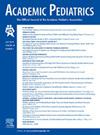Variation in Acute Pain Management of Youth With Nonfatal Firearm Injuries
IF 2.8
3区 医学
Q1 PEDIATRICS
引用次数: 0
Abstract
Objective
Firearm injuries are a leading cause of morbidity among youth, yet acute pain management practices have not been well characterized. Our objective was to evaluate acute pain medication administration by key sociodemographic characteristics and injury severity after nonfatal firearm injuries.
Methods
We performed a retrospective cross-sectional analysis utilizing Pediatric Health Information System at 40 US children’s hospitals from 2016 to 2021. We included inpatient and emergency department (ED) only encounters for patients 0–21 years old with a firearm injury diagnosis. The main outcome was administration of analgesic medications: none, nonopioid only, or at least 1 opioid. We included sociodemographic and injury severity score. Multivariable logistic regression was utilized to determine characteristics associated with the outcome.
Results
We included 4924 patients with nonfatal firearm injuries. By ED discharge versus admission, 39.0% versus 3.5% received no analgesia. For the 2522 patients discharged from the ED, younger children were more likely to receive no analgesia. Non-Hispanic White and Hispanic patients were more likely to receive no analgesia compared to non-Hispanic Black patients (adjusted odds ratios [aOR] 1.67 [95% confidence intervals 1.31, 2.31]; aOR 1.53 [1.18, 1.98], respectively). Receipt of opioids was lower among 5–9-year-old patients (aOR 0.40 [0.29, 0.54]), females (aOR 0.77 [0.62, 0.97]), and non-Hispanic White (aOR 0.59 [0.62, 0.75) and Hispanic patients (aOR 0.52 [0.40, 0.67]).
Conclusions
Among youth with nonfatal firearm injuries, analgesia administration varied greatest in the ED-discharged population. This suggests a need for further investigation into pain management practices focused on differences and potential undertreatment of pain in youth with nonfatal firearm injury.
非致命火器伤青少年急性疼痛处理的差异。
目的:枪支伤害是青少年发病率的主要原因,但急性疼痛管理实践尚未很好地表征。我们的目的是通过关键的社会人口学特征和非致命性火器伤害后的伤害严重程度来评估急性疼痛药物的使用。方法:我们利用儿科健康信息系统对2016-2021年美国40家儿童医院进行了回顾性横断面分析。我们纳入了0-21岁诊断为火器伤的住院和急诊科患者。主要结果是镇痛药物的使用:无,非阿片类药物,或至少一种阿片类药物。我们纳入了社会人口学和损伤严重程度评分。使用多变量逻辑回归来确定与结果相关的特征。结果:我们纳入了4924例非致命性火器伤患者。从ED出院和入院的对比来看,39.0%和3.5%的患者没有镇痛。在2522名从急诊科出院的患者中,年龄较小的儿童更有可能没有接受镇痛治疗。与非西班牙裔黑人患者相比,非西班牙裔白人和西班牙裔患者更有可能不接受镇痛治疗(aOR 1.67 [95% CI 1.31, 2.31];aOR分别为1.53[1.18,1.98])。5-9岁患者(aOR 0.40[0.29, 0.54])、女性患者(aOR 0.77[0.62, 0.97])、非西班牙裔白人患者(aOR 0.59[0.62, 0.75)和西班牙裔患者(aOR 0.52[0.40, 0.67])的阿片类药物使用率较低。结论:在非致死性火器伤的青少年中,镇痛给药在急诊科出院人群中变化最大。这表明需要进一步调查疼痛管理实践,重点关注非致命火器伤青少年疼痛的差异和潜在治疗不足。
本文章由计算机程序翻译,如有差异,请以英文原文为准。
求助全文
约1分钟内获得全文
求助全文
来源期刊

Academic Pediatrics
PEDIATRICS-
CiteScore
4.60
自引率
12.90%
发文量
300
审稿时长
60 days
期刊介绍:
Academic Pediatrics, the official journal of the Academic Pediatric Association, is a peer-reviewed publication whose purpose is to strengthen the research and educational base of academic general pediatrics. The journal provides leadership in pediatric education, research, patient care and advocacy. Content areas include pediatric education, emergency medicine, injury, abuse, behavioral pediatrics, holistic medicine, child health services and health policy,and the environment. The journal provides an active forum for the presentation of pediatric educational research in diverse settings, involving medical students, residents, fellows, and practicing professionals. The journal also emphasizes important research relating to the quality of child health care, health care policy, and the organization of child health services. It also includes systematic reviews of primary care interventions and important methodologic papers to aid research in child health and education.
 求助内容:
求助内容: 应助结果提醒方式:
应助结果提醒方式:


